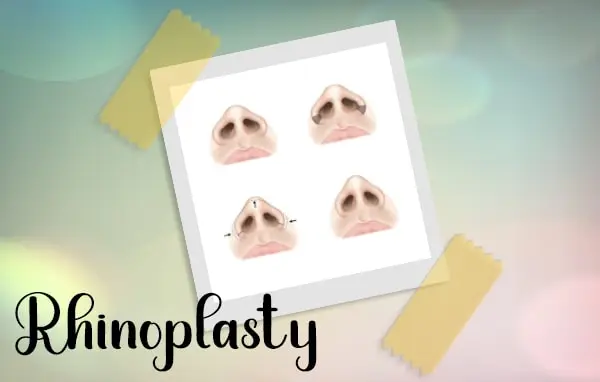
How is rhinoplasty for wide noses differents?
Rhinoplasty, colloquially known as a nose job, is a surgical procedure that aims to reshape the nose, enhancing its appearance and functionality. This transformative surgery is often sought by individuals seeking to address aesthetic concerns such as a crooked nose, prominent hump, or disproportionate nostrils. Additionally, rhinoplasty can also improve breathing difficulties caused by structural issues within the nose, enhancing both form and function. Skilled and experienced facial plastic surgeons are crucial in navigating the complexities of rhinoplasty, ensuring that each patient’s unique nasal characteristics are carefully addressed and harmonized with their overall facial features.
How wide is too wide for a nose?
It’s a query that delves into the intricacies of facial aesthetics, balancing personal preferences with societal standards. While some may argue that there’s no such thing as “too wide” when it comes to individual beauty, others may find themselves grappling with self-consciousness over the breadth of their nasal bridge. In the realm of cosmetic surgery, this question takes on a practical dimension, as patients seek rhinoplasty procedures to address perceived width discrepancies. Yet, the answer isn’t simply a matter of measurements; it’s about achieving harmony between one’s nose and the rest of their facial features. After all, beauty, much like the nose itself, comes in all shapes and sizes.
Can a wide nose be narrowed without surgery?
It’s a question that often arises in conversations about cosmetic enhancements and self-image. While some may dream of a non-invasive solution to sculpt their nose to their desired shape, the reality is a bit more nuanced. There are indeed non-surgical methods like contouring with makeup or dermal fillers that can create the illusion of a slimmer nose temporarily. However, these techniques typically offer subtle changes and may not be suitable for significant alterations. For those seeking more pronounced results, surgical options such as rhinoplasty remain the gold standard. It’s a decision that warrants careful consideration, balancing one’s desires with the potential risks and rewards of medical intervention. After all, the quest for self-confidence and beauty often involves navigating the complexities of both inner and outer transformation.
MAKEUP
Makeup, the transformative art of enhancing one’s natural beauty, has long been a beloved ritual for individuals worldwide. From subtle enhancements to dramatic transformations, makeup allows for endless creativity and self-expression. With a stroke of a brush and a dab of color, one can accentuate their best features, conceal imperfections, and unleash their inner confidence. Whether it’s mastering the perfect winged eyeliner, sculpting cheekbones with contour, or creating a flawless complexion, makeup serves as a powerful tool in the arsenal of self-care and empowerment. Beyond its cosmetic benefits, the act of applying makeup can also be a therapeutic practice, offering moments of mindfulness and self-reflection. In the ever-evolving world of beauty, makeup remains a timeless and indispensable companion, empowering individuals to both look and feel their best.
NON-SURGICAL RHINOPLASTY
Non-surgical rhinoplasty, a revolutionary alternative to traditional nose surgery, has emerged as a popular option for individuals seeking to refine the shape and contour of their noses without going under the knife. Unlike its surgical counterpart, which involves incisions and restructuring of nasal tissues, non-surgical rhinoplasty utilizes injectable fillers to sculpt and reshape the nose. This minimally invasive procedure offers several advantages, including reduced downtime, immediate results, and the ability to make subtle adjustments to nasal aesthetics. Whether it’s correcting minor asymmetries, smoothing out bumps, or lifting drooping nasal tips, non-surgical rhinoplasty provides a customizable solution tailored to each patient’s unique needs. With its growing popularity and advancements in techniques and materials, non-surgical rhinoplasty has become a sought-after option for those seeking a temporary yet impactful enhancement to their nasal appearance.
Can rhinoplasty fix a wide nose?
Absolutely. When carried out by the right surgeon, rhinoplasty can be an effective solution for narrowing a nose that may seem excessively wide in relation to the overall facial features of the patient.
This procedure employs a range of techniques tailored to the individual’s unique concerns and desired outcomes. Several common approaches exist for addressing a wide nose through rhinoplasty:
NASAL BONE RESHAPING
Nasal bone reshaping, a key component of rhinoplasty, involves altering the structure and contour of the nasal bones to achieve desired aesthetic results. This procedure is often employed to address issues such as a prominent nasal bridge, a dorsal hump, or asymmetry in the nasal bones. During the surgery, the surgeon carefully accesses the nasal bones through small incisions, then utilizes specialized techniques to sculpt and reshape them according to the patient’s preferences. Whether it’s narrowing the bridge, smoothing out irregularities, or addressing fractures, nasal bone reshaping plays a crucial role in creating a harmonious and balanced nasal profile.
CARTILAGE REDUCTION
Cartilage reduction is a fundamental aspect of rhinoplasty aimed at refining the shape and structure of the nasal tip and septum. Excess or misshapen cartilage can contribute to a wide or bulbous nasal tip, asymmetry, or breathing difficulties. During the procedure, the surgeon delicately trims and reshapes the cartilage using precise surgical instruments, sculpting it to achieve the desired size, projection, and symmetry. By strategically removing or repositioning cartilage, cartilage reduction not only enhances the aesthetic appearance of the nose but also improves its function, resulting in a more balanced and harmonious nasal profile.
ALAR BASE REDUCTION
Alar base reduction is a specialized technique within rhinoplasty designed to address the width of the nostrils and the flare of the nasal base. Individuals with wide nostrils or excessive flaring may feel self-conscious about the appearance of their nose. Alar base reduction offers a solution by narrowing the width of the nostrils and refining the shape of the nasal base to achieve a more proportionate and aesthetically pleasing nasal appearance. During the procedure, the surgeon carefully excises a precise amount of tissue from the base of the nostrils, ensuring symmetrical and natural-looking results that complement the overall facial features.
SEPTOPLASTY
Septoplasty is a corrective surgical procedure aimed at straightening and repositioning the nasal septum, the thin wall of cartilage and bone that divides the nasal cavity into two nostrils. Deviations or abnormalities in the septum can lead to breathing difficulties, nasal congestion, and snoring. During septoplasty, the surgeon accesses the septum through small incisions within the nose, then carefully reshapes and repositions the deviated portions to improve airflow and restore nasal function. By addressing underlying structural issues, septoplasty not only enhances breathing but also contributes to a more balanced and aesthetically pleasing nasal appearance.

Types of wide nos rhinoplasty : open vs closed
Open and closed rhinoplasty are the two primary surgical techniques used for nose reshaping, each offering distinct advantages depending on the patient’s needs and the surgeon’s expertise. Both methods can effectively address concerns related to a wide nose, such as reducing nasal width, refining the nasal tip, or correcting asymmetry. However, the choice between open and closed rhinoplasty depends on various factors, including the complexity of the procedure, the patient’s nasal anatomy, and their desired aesthetic outcomes. While open rhinoplasty involves making a small incision on the columella, the strip of tissue between the nostrils, providing the surgeon with direct access to the nasal structures, closed rhinoplasty utilizes internal incisions within the nostrils, resulting in minimal external scarring. Ultimately, the decision between open and closed rhinoplasty is a collaborative effort between the patient and the surgeon, with the goal of achieving optimal results while preserving the natural harmony and balance of the facial features.
OPEN RHINOPLASTY:
Open rhinoplasty is a surgical approach to nose reshaping that involves making a small incision on the columella, the strip of tissue between the nostrils. This technique allows the surgeon to lift the skin of the nose, providing a direct view and access to the underlying nasal structures. Open rhinoplasty is often preferred for more complex cases where extensive reshaping or reconstruction is required. By offering enhanced visibility and precision, this method enables the surgeon to achieve precise adjustments to the nasal tip, bridge, and overall contour. While open rhinoplasty may result in a small scar on the columella, its benefits in terms of surgical control and predictability often outweigh this concern, leading to satisfying and long-lasting results for patients.
CLOSED RHINOPLASTY:
Closed rhinoplasty, also known as endonasal rhinoplasty, is a surgical technique for nose reshaping that involves making internal incisions within the nostrils, without any external scarring. Unlike open rhinoplasty, which requires an incision on the columella, closed rhinoplasty utilizes hidden internal access points, providing limited visibility of the nasal structures. Despite this limitation, closed rhinoplasty offers several advantages, including reduced surgical trauma, faster recovery times, and minimal risk of external scarring. This approach is well-suited for patients seeking more conservative changes to their nasal appearance, such as refining the nasal tip or addressing minor asymmetries. While closed rhinoplasty requires a high level of surgical skill and expertise to achieve optimal outcomes, it remains a popular choice for individuals looking to enhance their nasal aesthetics with minimal disruption to their daily lives.
Bulbous tip nose job (Tiplasty)
The bulbous tip nose job, also known as tiplasty, is a specialized procedure tailored to those seeking refinement in the appearance of their nasal tip. Characterized by a rounded or overly prominent tip, a bulbous nose can often be a source of self-consciousness for individuals. Tiplasty offers a solution by delicately reshaping and sculpting the nasal tip to achieve a more balanced and proportionate appearance. This procedure typically involves techniques such as cartilage trimming, suturing, and reshaping to create a more defined and refined nasal tip contour. The goal of tiplasty is not only to enhance the aesthetic appearance of the nose but also to restore harmony to the overall facial features, instilling confidence and satisfaction in the patient. With its focus on precision and artistry, tiplasty serves as a testament to the transformative power of modern cosmetic surgery in helping individuals achieve their desired aesthetic goals.
Wide nose rhinoplasty recovery
Recovering from wide nose rhinoplasty is a journey that requires patience, diligence, and self-care. Following the surgical procedure aimed at narrowing the width of the nose, patients can expect a period of swelling, bruising, and discomfort. While every individual’s recovery experience is unique, there are common steps and precautions to take to ensure a smooth healing process. Initially, patients may experience swelling and bruising around the nose and eyes, which gradually subsides over the following weeks. Pain medication prescribed by the surgeon can help manage any discomfort during this time. It’s essential to follow post-operative care instructions provided by the surgical team diligently, which may include keeping the head elevated, applying cold compresses to reduce swelling, and avoiding strenuous activities. As the weeks pass, patients will notice gradual improvements in the appearance and function of their nose, with final results becoming more apparent over several months. Throughout the recovery period, open communication with the surgeon and regular follow-up appointments are crucial to address any concerns and ensure optimal healing and outcome. With proper care and patience, patients can look forward to enjoying the newfound confidence and satisfaction that comes with their refined nasal appearance.









